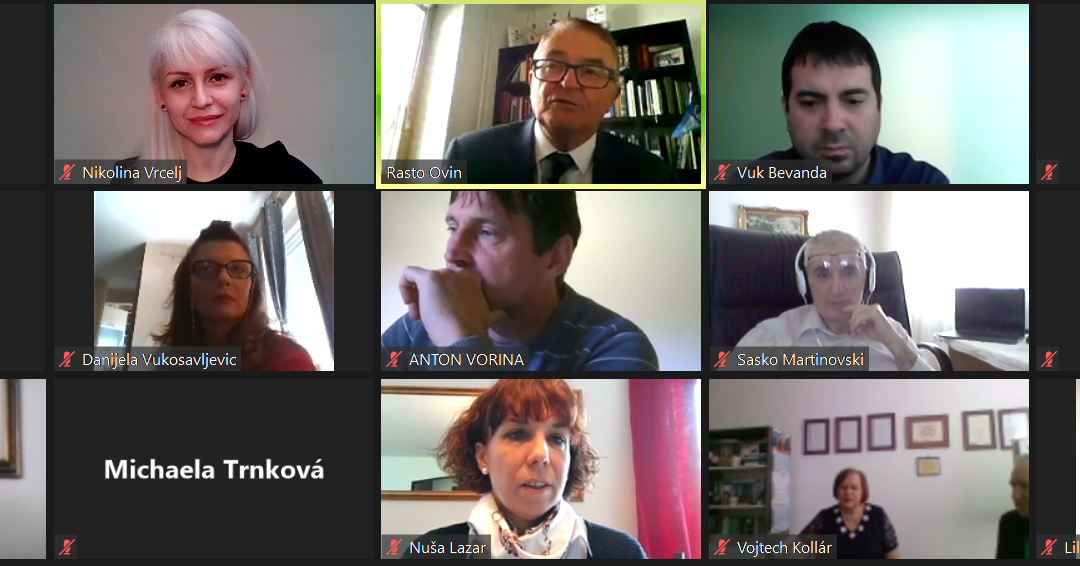Do Employers Have Control Over the Collection and Distribution of Tips?
Case Study: Slovenia and Montenegro
Stevo Nikić – Faculty for Mediterranean Business Studies Tivat, Adriatic University Bar, Montenegro
Andrej Raspor – CEATM d.o.o., Dolga Poljana, Slovenia
Nikola Vukčević – Faculty for Mediterranean Business Studies Tivat, Adriatic University Bar, Montenegro
7th International Scientific ERAZ Conference – ERAZ 2021 – Selected Papers: KNOWLEDGE BASED SUSTAINABLE DEVELOPMENT, Online/virtual, May 27, 2021
ERAZ Conference Selected Papers are published by: Association of Economists and Managers of the Balkans – Belgrade, Serbia
ERAZ conference partners: Faculty of Economics and Business, Mediterranean University, Montenegro; University of National and World Economy – Sofia, Bulgaria; Faculty of Commercial and Business Studies – Celje, Slovenia; AMBIS University, Prague – Czech Republic; Faculty of Applied Management, Economics and Finance – Belgrade, Serbia
ERAZ Conference 2021 Selected Papers ISBN 978-86-80194-47-9, ISSN 2683-5568, DOI: https://doi.org/10.31410/ERAZ.S.P.2021
Keywords:
Tipping;
Employers;
Tip sharing;
Slovenia;
Montenegro
Abstract:
Objective: The purpose of this paper was to determine whether tipping could reduce labor costs in the service sector. This research aims to better understand whether employees are more motivated to work because of the tip they receive.
Methodology: We will achieve these goals based on the findings of the research from Slovenian and Montenegrin companies in 2019 and 2020. A quantitative survey was implemented on a convenience sample of 107 Slovenian, and 59 Montenegrin companies, using the non-probability sampling technique. Statistical data analysis was carried out with the help of IBM Statistic Package for Social Science (SPSS) software version 20. We investigated the area of tips from the point of view of the orderliness of the distribution of tips, what are the relations in Slovenia and Montenegro and whether the tip as a motivational activity is sufficiently used in these two countries.
Originality: Tipping has received little attention in rewarding and motivating employees. Furthermore, there is no good, national source of guidance to help managers make decisions about tipping policies. This paper addresses these voids in Slovenia and Montenegro. Only a comprehensive discussion will be able to bridge this gap.
Results: According to employees, the overall satisfaction with tips is better in Montenegro. Most employees allow the collection of tips, which is more present in Montenegro. In Slovenia, there is a regulated system of distribution of tips, while in Montenegro this system is not clearly defined. Moreover, in Slovenia, there is also an orderly system for the collection and sharing of tips. Due to this fact, in Slovenia, the distribution of tips includes both, the employees who are directly involved in providing services as well as their colleagues. By contract, in Montenegro, only employees directly involved in providing services are entitled to a tip.
Practical implications: In order to decrease labor costs, we propose that the management takes control of tipping and integrates tips into the reward system. Also, the employees should be made aware of how tipping improves service and increases their income.
Limitations: The sample was formed by the questionnaire that was distributed to various companies in the service sector as a non-probability method based on referrals from initial subjects to get another subject. The questionnaire was sent by e-mail directly. The data were obtained by the Chamber of Commerce of Slovenia and the Chamber of Commerce of Montenegro. The main problem with small samples is the interpretation of results. Therefore, the results cannot be fully generalized. This issue should be addressed in future tipping studies.

ERAZ Conference
Creative Commons Non Commercial CC BY-NC: This article is distributed under the terms of the Creative Commons Attribution-Non-Commercial 4.0 License (https://creativecommons.org/licenses/by-nc/4.0/) which permits non-commercial use, reproduction and distribution of the work without further permission.

References
An-Tien Hsieh & Der-Huang Wu (2007) The Relationship between Timing of Tipping and Service Effort, The Service Industries Journal, 27:1, 1-14, DOI: 10.1080/02642060601038593
Arnold, J., Randall, R., & Patterson, F. (2010). Work psychology: understanding human behaviour in the workplace. Harlow (England): Financial Times Prentice Hall.
Armstrong, M. (2003). A handbook of human resource management practice. London: Kogan Page.
Azar, O. H. (2011). Business strategy and the social norm of tipping. Journal of Economic Psychology, 32(3), 515-525.
Barnes, H. (2003). Gender Differences in Restaurant Tipping.
Boone, L. E., & Kurtz, D. L. (1992). Management. New York [etc.]: McGraw-Hill.
Bujisic, M., Parsa, H. G., Bilgihan, A., Galloway, J., & Hern, L. (2014). Service Failure, Tipping Behavior, and the Effect of Service Industry Experience. Journal of Quality Assurance in Hospitality & Tourism, 15(3), 253–268. doi:10.1080/1528008x.2014.921774
Clotildah, K., Charity, M., Felistas, C., & Tatenda, C. (2014). The perceptions of employees towards tipping and motivation in the hotel industry. African Journal of Hospitality, Tourism and Leisure, 3(1), 1-12.
DuBrin, A. (2002). Fundamentals of organizational behavior. Cincinnati (Ohio): South-Western.
Fernandez, G. A. (2004). The Tipping Point— Gratuities, Culture, and Politics. Cornell Hotel and Restaurant Administration Quarterly, 45(1), 48–51. https://doi. org/10.1177/0010880403260106
Garrity, K., & Degelman, D. (1990). Effect of server introduction on restaurant tipping. Journal of Applied Social Psychology, 20, 168-172.
Herzberg, F. (1959). The motivation to work. New York: Wiley.
Ineson, E. M., & Martin, A. J. (1999). Factors influencing the tipping propensity of restaurant customers. Journal of Retailing and Consumer Services, 6(1), 27–37. doi:10.1016/s0969- 6989(98)00003-4
Kakkar, V., & Li, K. K. (2021). Cash or Card? Social Image Concern and Restaurant Tipping Behavior. Social Image Concern and Restaurant Tipping Behavior (March 16, 2021).
Kerr, P. M., & Domazlicky, B. R. (2009). Tipping and service quality: results from a large database. Applied Economics Letters, 16(15), 1505-1510.
Kim, S. H. (1996). 1001 Ways to Motivate Yourself and Others. Wethersfield: Turtle Press.
Johnson, B. (1999). Introducing management: a development guide for new managers. Oxford [etc.]: Butterworth-Heinemann.
Lee, J., Rafieian, H., Aggarwal, A., & Korschun, D. (2017). How Power Affects Consumers’ Tipping Behavior. In Creating Marketing Magic and Innovative Future Marketing Trends (pp. 1019-1023). Springer, Cham.
Lin, I. Y., & Namasivayam, K., (2011). Understanding restaurant tipping systems: A human resources perspective. International Journal of Contemporary Hospitality Management, 23(7), 923–940. https://doi.org/10.1108/09596111111167533
Lynn, M, & Sturman, M. (2010). Tipping and service quality: A within-subjects analysis. Journal of Hospitality and Tourism Research, 34(2), 269–275. http://www.scopus.com/inward/ record.url?eid=2-s2.0-77951660879&partnerID=40&md5=8d58a0ea2ffa136b08b1230ecb679b1f
Lynn, Michael, & Mynier, K. (1993). Effect of Server Posture on Restaurant Tipping. Journal of Applied Social Psychology, 23(8), 678–685. https://doi.org/10.1111/j.1559-1816.1993. tb01109.x
McCall, M., & Lynn, A. (2009). Restaurant servers’ perceptions of customer tipping intentions. International Journal of Hospitality Management, 28(4), 594–596.
Namasivayam, K., & Upneja, A. (2007). Employee preferences for tipping systems. Journal of Foodservice Business Research, 10(2), 93–107.
Nikić, S. (2012). Sociologija turizma i održivi turizam. Fakultet za mediteranske poslovne studije Tivat, Pegaz.
Parrett, B. M. (2003). The Give and Take on Restaurant Tipping. Virginia Polytechnic Institute and State University. https://theses.lib.vt.edu/theses/available/etd-10172003-021146/unrestricted/ETDDissertation.pdf
Raspor, A. (2002). Napitnina kot dodatna stimulacija za delo. Organizacija, 35(5), 285–295.
Raspor, A. (2007). Napitnina v gostinstvu. Organizacija, 40(3), A27–A37.
Raspor, A. (2015). Dejavniki, ki vplivajo na napitnino v igralnici. Strokovne e-novice. http://metaiskalnik.izum.si/sfxlcl41?url_ver=Z39.88-2004&url_ctx_fmt=info%3Aofi%3Afmt%3Akev%3Amtx%3Actx&ctx_ver=Z39.88-2004&ctx_enc=info%3Aofi%2Fenc%3AUTF-8&rft_val_fmt=info%3Aofi%3Afmt%3Akev%3Amtx%3Ajournal&rft.856_URL=http%3A%2F%2Fwww.energos-svetovanje
Raspor, A. (2021), Napitnine: Orodje za povečanje učinkovitosti poslovanja podjetja, BoMa
Raspor, A., Lacmanović, D., & Lacmanović, J. (2018). Tipping habits in hospitality industry in Montenegro. https://thi.fthm.hr/congress-proceedings/send/5-2018/124-tipping-habits-in-hospitality-industry-in-montenegro
Raspor, A., Miglič, G., Vukovič, G., & Rodič, B. (2013). The role of tipping in reducing labour costs. Pametna organizacija: 32. mednarodna konferenca o razvoju organizacijskih znanosti, 886–898.
Robbins, S., & Coulter, M. K. (2009). Management. Upper Saddle River (N.J.): Pearson Prentice Hall.
Sarwar, S., & Abugre, J. (2013). The influence of rewards and job satisfaction on employees in the service industry. The Business & Management Review, 3(2), 22.
Shamir, B. (1984). Between gratitude and gratuity an analysis of tipping. Annals of Tourism Research, 11(1), 59-78.
Whaley, J. E., Douglas, A. C., & O’Neill, M. A. (2014). What’s in a tip? The creation and refinement of a restaurant-tipping motivations scale: A consumer perspective. International Journal of Hospitality Management, 37, 121–130. doi:10.1016/j.ijhm.2013.11.005

